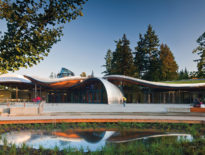Matera, Italy: the original Living Community?
In a prehistoric ravine carved out by a Mediterranean river lies the city of Matera, a unique place where the lines distinguishing the environment from the built environment have faded with the patina of time. The former invades the latter, natural caves become dwellings, and the rock-hewn dwellings become natural in a steady osmotic relationship that continues today.
This past February the Living Building Challenge was brought to the heart of Matera. In an event organized by the Living Building Challenge Collaborative in Italy, more than 120 architects and engineers gathered to discuss the how the past can inform the future, and how Matera stands as a case study of the Living Building Challenge philosophy.
Matera: From national shame to the heritage of humanity
Inhabited since the 10th century BC and abandoned after WWII, the historical city center of Matera, the “Sassi”1 was inscribed on the UNESCO World Heritage List in 1993 and acknowledged as an
“Outstanding example … for future generations on how to use natural resources such as the sun, the rock and the water” (Criterion 3)
“A relevant example of an architectural ensemble and landscape illustrating many significant stages in human history” which led to the creation of “sophisticated urban structures built with excavation materials” (Criterion 4)
“Relevant example of traditional human settlement … which has maintained a harmonious relationship with its natural environment and a balance between human action and ecosystem for over nine millennia” (Criterion 5)
A settlement model characterized by a close relationship with the nature of the place, every point of Matera, from the Sasso Barisano to the Civita, to the Sasso Caveoso, is closely related to the ravine.2 This environmental characteristic gives the city several layers: From the changing color of the rock to the sound of the water playing the soundtrack of the day.
The surrounding architecture showcases the basic principles of community health and happiness. The people-oriented environment consists of biophilic places with invisible connections allowing flexibility, efficiency, and freedom. The houses preserve the features that have been characterizing them for millennia, in a practical dialogue with the contemporary that contributes to its protection.
Stone, wood, glass, and iron can be found in the facades, in the doors of the caves, in the small windows and the railings. Their use paints a particular view of the Sassi, where colors and materials join the spikes of the rock and the blue of the sky in a silent dance of beautiful images.
Time is kept by the sun dancing with structure shadows, following each other to the bottom of the rock-hewn caves. The natural light, a symbol of life and color, has built these environments, tracing the excavation line of the caves and lighting up their depths. The few motor vehicles that can reach the houses and slow mobility offer unexpected silences and an unparalleled quality of life in the open air.
A multitude of hanging gardens cover the patios; vines climb, like spiders, out of the dug-out walls at noon. The geological landscape becomes building material and protagonist to everyday life. The natural forms of the bending paths designed for donkeys flourish today with botanical species. Everything coils up from the water collecting channels, where both fast vortices and the transparent slits of vast and placid cisterns, rest, immobile and seemingly eternal.
Everything appears as a picture of humanized nature. The paths and the internal environments change with seasons and time; open and close to intertwine within public and private needs. Interconnected, like the arteries and capillaries of living beings.
And like flesh, history takes its toll. The first laws to help Matera evolve from “shame” to “heritage” provided for the relocation of the Sassi inhabitants to new districts, and the allocation of abandoned houses, slated as uninhabitable, to the state property. In 1986, the government started an extensive rehabilitation project, and the overall coherence the settlement achieved evokes the particular emotions that can be experienced in the city of Matera today. Thus, the Sassi districts of Matera are an outstanding example of the history characterizing the unique regenerative value of many European towns.
Matera: A Living Community?
The evolution of Matera as human settlement exemplifies the regenerative building paradigm, particularly evident in two elements of the Sassi:
- A spatial arrangement organized around shared spaces where the inhabitants carried out collaborative practices for the management of daily activities;
- The full integration of human settlement in the natural environment, obtained by developing and improving construction techniques aimed at using the orographic features to adapt to the dry climate of the site. The element that has decisively influenced urban development is the need to guarantee water supply through the collection and storage of spring and rainwater with an extensive and widespread system of pipes and cisterns.
During this past February, the experience of Matera was the context in which the group discussed the Living Building Challenge and Living Community Challenge. Alicia Daniels Uhlig shared the Living Community Challenge protocol with the 120 architects and designers in attendance. In his welcoming address, Michele Massaro, one of the members of the Italian Collaborative, underlined how the urban development practices of Matera exemplify a built sustainable environment. Giuseppe Larato, another Collaborative member, summarized the most popular protocols on the sustainability of buildings, paving the way for a discussion on the Living Building Challenge.
The discussions that followed inspired: Francesco Fiorito, from the Politecnico of Bari, highlighted the importance of reducing the island heat effect in urban centers; Fabio Fatiguso analyzed the Sassi as a case study of urban resilience to counteract the effects of climate change. Finally, I gave an overview of the LBC protocol and described the mission of the International Living Future Institute.
Matera stands as a model of a community of high spirituality and beauty, which—as Stendhal said—”…is a promise of happiness.” Truth, authenticity, and a strong sense of empathy pervaded the conversation, as it has the city for a millennium. Having Matera as both backdrop and palimpsest for this event created a path to balance the ancient and the modern, and introduce the philosophy to new practitioners.
This article was written in collaboration with Giuseppe Larato, Michele Massaro and Michele Scavetta.
Notes
- The name “Sassi” in Matera refers to two large districts that together with the “Civita” and the “Piano” form the historic center of the city of Matera.
- The ravine is typical karst morphology of the Murgia plateau. The ravines are deep erosive cuts even more than 100 meters deep, very similar to canyons, dug into the rock by rainwater. Its walls, which are very steep and vertical in some cases, may be a few meters or more than 200 meters from each other.




